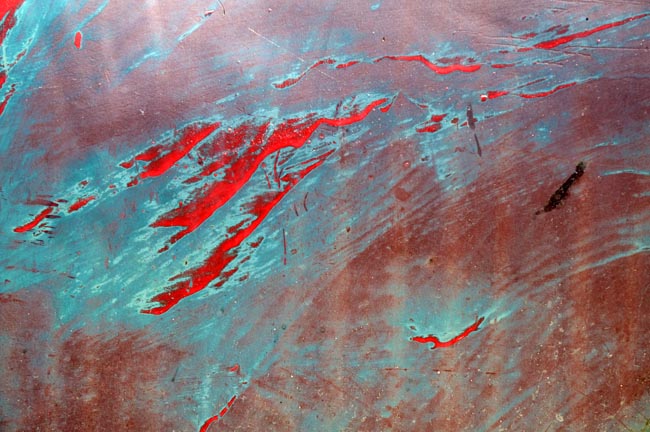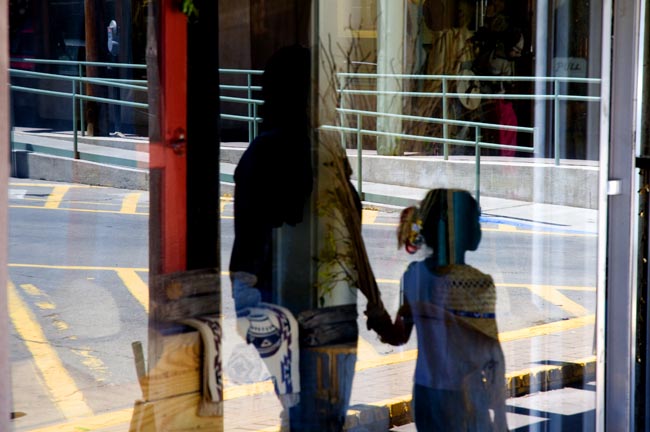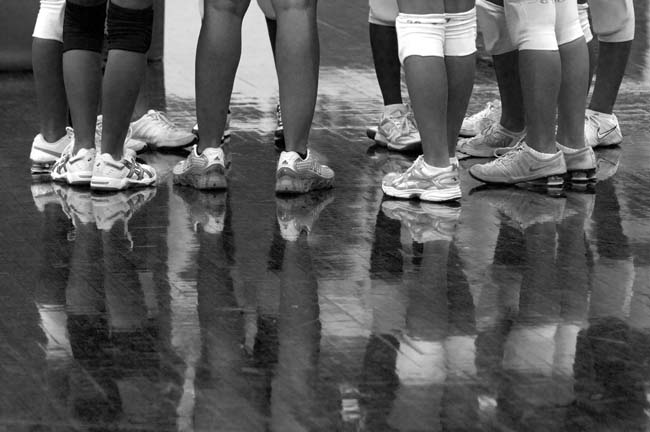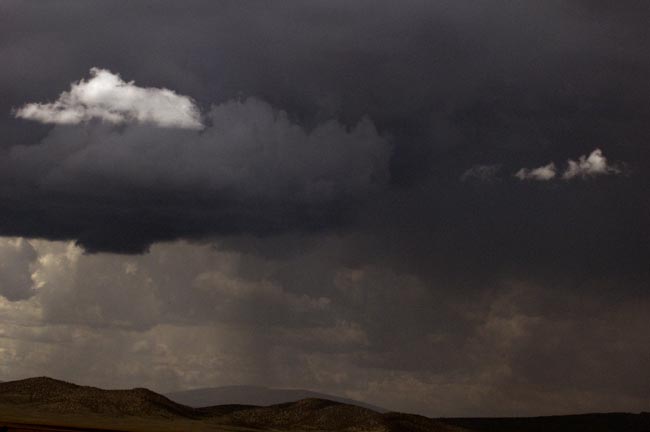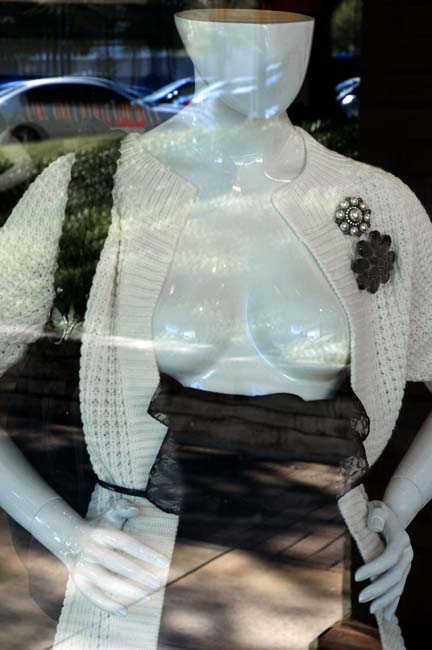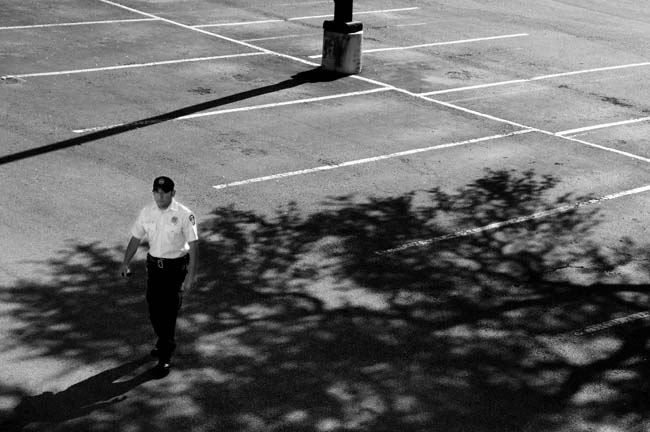Mother and child
What kind of world is this child growing up in? Straight lines and guard rails imply limits; yellow road markings signal regulation. A parking meter – pay up or be fined. Nothing natural in this world; only a dead plant inside. The pot design and border pattern of the rug in store window remind of an older culture with fewer lines.
Could the red door be an exit? Is it locked, is it forbidden, is it dangerous? Is it too late to turn back and find out?
Timeout
Another weekend, another volleyball tournament; the last of this middle school season. As with the earlier tournament (see Knee Pads and Blue Filters) my photographic focus was on the feet – no parent wants a stranger pointing a telephoto lens at their teenage daughter. It turns out that feet can say a lot without the rest of the body.
Storm Clouds
The VFXY Photos theme for the week is “Storm Clouds”. Picking a submission was not so easy, there are a dozen in my catalog that I could have used. I chose this one partly because it reminds me of our most recent vacation and the rental house that we stayed in, Casa De Cuentos , from which it was taken.
Summer is monsoon season in New Mexico and storms often assemble in the afternoons making for dynamic sky-scapes. You can find more examples in the White Sands & New Mexico selection on the main Web site.
You can see all the submissions to the current VFXY theme at /photos.vfxy.com/themes.
Fall Fashion
A bare breasted Amazon, with a bad headache, front and center in a north Austin strip mall store window. An inebriated Spring Break reveler selling clothes.
Perhaps this is the real reason that the strip mall operators didn’t want me to take pictures on Sunday morning? See the previous post for a discussion of that incident.
I could hardly believe it when I saw this display in a national chain store window. Was it really a deliberate choice or an accident? Are topless celebrities so normal that we expect the general public to adopt this as the fall fashion?
This is the latest addition to the Store Life series; you can see more in the Store Life Revisited selection of the parent Web site.
The threat level is Gray
I was very pleased when this security guard walked into my viewfinder – you don’t get much human subject matter in a Austin strip mall at 10:30 on a Sunday morning. I was focused on the lines and shadows on the tarmac and not sure of the interest until his feet entered at the top right of the frame; now here was something to work with.
I did not know it at the time but the man had walked across the parking lot just to stop me from photographing it. Apparently, after 9/11, taking photographs of and around public spaces like strip malls is considered a security risk. He was very courteous about it; I think we both found it a little embarrassing. I left smiling at the absurdity but disturbed by the implications; it is not the first time I have been asked not to photograph a store building but it is the first time I have been given such a disingenuous and dangerous reason. The guard was just doing his job – the mall owners are either taking advantage of our cultural neurosis or hysterically subject to it.
Google will produce a 40 foot to one inch satellite image of the same mall with less than 10 seconds effort; the Street View feature adds a drive by perspective from the nearby highway. With Google I can identify every ladder, stair well and alley around the building. With a cell phone camera I could photograph everything else without giving myself away. Stopping the obvious photographer with his clunky SLR reduces the information available to malicious minds not one pixel.
Denying people the right to take photographs in public spaces is unconstitutional and illegal, and it provides nothing but a false sense of security. It is dangerous – we think we have achieved something that we have not. We think we have bought security in exchange for a little freedom but we have been duped, and the freedom we lose is a thread pulling from the very fabric that we treasure. If this false logic is followed unchecked then we can photograph no one and nowhere but inside our homes with the blinds drawn.
I suspect that the mall owner’s real concerns are financial and that the security excuse is a conscious or unconscious smoke screen. The owners fear bad publicity from photographs of trash or empty stores on their property, they fear investigators gathering evidence for a law suit, they don’t know what they fear exactly but if there are no photographs then they can feel safe and in control.
As to the law, to quote Andrew Kantor* from USA Today, “If you can see it, you can shoot it.” An Unfortunate turn of phrase in the circumstances but, excluding military bases and using telephoto lenses to invade a person’s belief of privacy, you have a right to photograph pretty much whatever you want.
September 29, 2008 – Addendum: After I made this post I found out that Andrew Kantor had also gathered his research into a separate document, Legal Rights of Photographers, available as a PDF on the home page of his blog, Andrew Kantor’s Place. If you are a photographer you might want to print this out and keep a copy in your camera bag :-)
Other Resources:
- *Kantor, A. (2005, Dec 29). New digital camera? Know how, where you can use it. USA Today. Retrieved Sep 28, 2008, from http://www.usatoday.com/tech/columnist/andrewkantor/2005-12-29-camera-laws_x.htm
- Matthews, N. (2006, July). The War on Photographers. PopPhoto.com. Retrieved Sep 28, 2008, from http://www.popphoto.com/popularphotographyfeatures/2668/the-war-on-photographers.html
- Press Release (2005, August 27). NPPA Releases Memo On Photographers’ Rights To Take Pictures In Public Places. National Press Photographers Association. Retrieved Sep 28, 2008, from http://www.nppa.org/news_and_events/news/2005/08/rights.html
- Wimmer, K. & Blevins, J. (2005, August 15). Rights of Journalists on Public Streets. Covington & Burling. Retrieved Sep 28, 2008, from http://www.nppa.org/news_and_events/news/2005/08/rights.pdf
